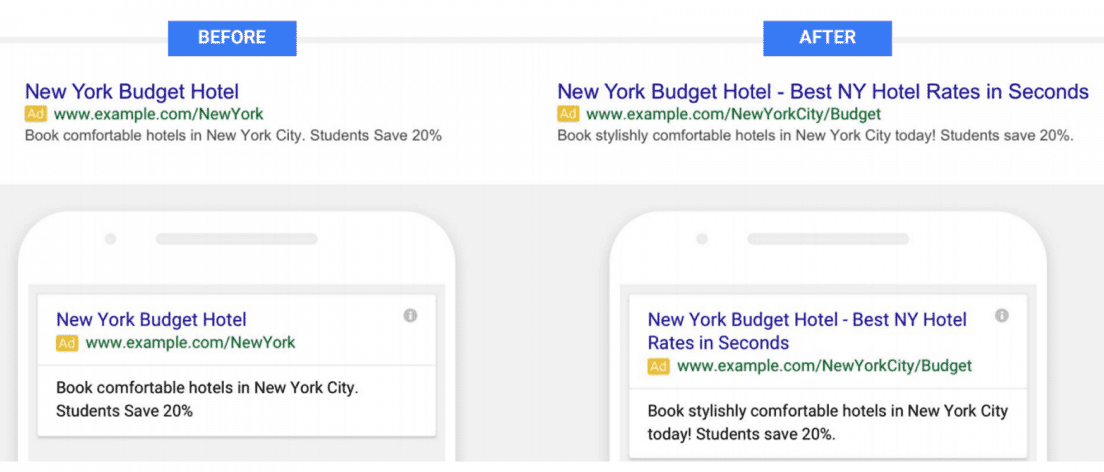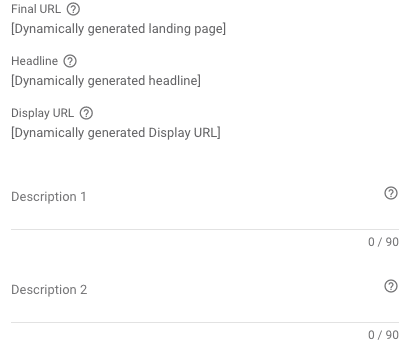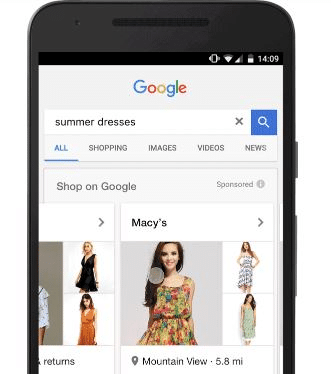Google’s forever changing ad landscape has posed many implications to the ways in which advertisers are able to communicate their messages to users. A look into the way they’ve developed their ad formats over the years shows encouraging signs for advertisers who are looking to utilise the various ad formats to their fullest potential.
After Google have continued to develop a variety of ad types, advertisers now have a range of formats to utilise across both traditional text ads and shopping ads. Here’s an overview of each ad’s purpose and how to maximise their success.
#1 – Expanded Text Ads (ETAs)
When Google introduced Expanded Text Ads in 2016 and started to phase out Standard Text Ads from January 2017, it allowed advertisers to engage and connect with their audience more effectively. By expanding the space in which advertisers were allowed to utilise by 50%, this reportedly drove CTRs up by an average of 20%.

From a technical format perspective we saw a change in character limit from 25-35-35 under the old Standard Text Ads format up to a much more generous 30-30-80 under the newer Expanded Text Ad format. From an advertising perspective this gave advertisers the ability to tailor their messaging more effectively, whilst also conveying the brand messaging more distinctively. In addition to this, the SERP (search engine results page) real estate expansion gave advertisers a larger space to convey their messaging across, making the ads more prominent to searchers.
#2 – Responsive Search Ads (RSAs)
Just as ETAs replaced their predecessor, Responsive Search Ads are predicted to replace ETAs after presenting another dimension of adaptability. In early 2018, Responsive Search Ads were made widely available in beta with Google encouraging advertisers to adopt the new ad format. And for very good reason.
The transition from ETA to RSA is arguably the most explorative change which Google has made across search ad formats, and marks their commitment towards increased automation and AI learning. There are two key changes which have changed the search ad landscape for advertisers which are:
- The ability to create up to 15 different headlines and 4 different description lines; throwing in a description character limit expansion from 80 to 90 for good measure.
- Rotating headlines and description lines automatically in order to show the most relevant variation to the initial search query.
With Google’s push towards automation, it comes as no surprise that they’ve integrated machine learning into their new ad format. With advertisers experiencing mixed performances from other automotive features, we can understand why there may be a level of skepticism around the new formats. However with Google’s algorithms becoming more reliable, especially once they’ve gathered a reasonable amount of data, the ability for ads to adapt to queries based on data signals will outshadow non-responsive ads and give a competitive edge to those who have adopted them.
From an ad format perspective, the release of Responsive Search Ads was also met with a description character limit expansion from 80 to 90 and a change to ad delivery which sporadically includes a third headline and second description line when showing ads. After we saw the improved CTRs after developing from Standard Text Ads to ETAs, this gives advertisers further space to utilise when communicating with their audience.
The character expansion and ad delivery change was also rolled-out across ETAs in August 2019 for the purpose of display format consistency.
#3 – Dynamic Search Ads (DSAs)
One other search ad format which is often pushed aside is the Dynamic Search Ad. Unlike the other ad formats, DSAs can only be applied to specific DSA campaigns which crawl websites for relevant search terms and automatically match towards these search terms. Despite the inability to apply these ads across all campaigns, they should certainly not be ignored and present a different dynamic to advertisers.

In some regards, Dynamic Search Ads have pathed the way for RSAs and are a pseudo-hybrid of the AI mechanics behind RSA combined with traditional static messaging. DSAs consist of a dynamic headline one, a dynamic URL as headline two, two static description lines, and adopt the final URL from the landing page where the original query matched to. So essentially, DSAs will dynamically adapt towards the user’s search query but the messaging within both description line one and two will remain static.
Best Practices Across Text Ads
- Each ad group should be equipped with 1 RSA and 2 ETAs. Google currently favours RSAs over ETAs meaning the majority of ads shown will be RSAs, but it’s recommended to have backups in place. RSAs are likely to replace ETAs at some stage in 2020 so preparation in advance is advised.
- RSAs give advertisers the option to ‘pin’ specific headlines and descriptions to specific positions. It’s advised to pin headline 1 to position 1 with the keyword as the text, whilst it can also be beneficial to pin headlines and descriptions across sale periods where certain messages need to be shown every time.
- DSAs should not be ignored. It’s still useful to use this ad and campaign format in order to mine new keywords, and the dynamic changing headline and URL means that relevancy will always be reasonably strong. It is not recommended to solely use DSAs where the lack of tailoring across all other headlines can hinder relevancy.
#4 – Standard Shopping
The Google shopping service has been the core Google advertising service for many ecommerce retailers, allowing users to be matched directly to products from within advertisers’ product inventories which have relevance with the search query.
In contrast to search, the developments across the core offering of shopping have remained fairly solidified over time, with the simplistic product + price + retailer format remaining static. Of course, advertisers can utilise extensions such as the product rating extensions which will pull in to the ads along with the ability to advertise promos and discounts too.
The most significant change to the appearance of shopping ads over the last few years has been the introduction of many Comparison Shopping Services (CSS) with the likes of Kelkoo and Productcaster being listed at the bottom of shopping advertisements. The introduction of third party shopping comparison services increased across 2019 after Google was fined for favouring its own shopping service over competitors,
#5 – Showcase Shopping
The biggest development across shopping has been the introduction of the new Showcase Shopping ad format which is exclusively shown across both mobile and tablet devices. This latest ad format allows users to engage with a brand more effectively with a variety of products being shown from a specific advertisers’ inventory. This format gives advertisers the ability to ‘showcase’ a number of products which may be relative to the user query.

In addition to improving user engagement with the brand and displaying a variety of products, it can also be an effective tool for mining new keywords which are relevant to specific product ranges.
Best Practices Across Shopping Ads
- Traditional shopping ads are still as effective as they’ve always been, linking users directly to products sat within your inventory. Most agencies have considered using Comparison Shopping Services, although having the CSS listed within the ad doesn’t seem to have any implications on CTR.
- Showcase ads are a great opportunity to show users multiple products at once whilst enforcing your brand too. Consider implementing showcase ads, segmenting by products which sit within common categories.
Maximising Success on Google
Google is often introducing new ad types whilst also making alterations to current formats. This is centered around improving their ad service for users, and connecting users with products and services using a variety of ad formats. With Google introducing these new formats so often it’s important that advertisers keep up to date with the latest releases and keep testing new ad formats.
PPC is constantly evolving. We are ecommerce growth experts and will use our expertise and experience to deliver award-winning Google Ads campaigns that deliver results. If you need help with your PPC strategy, get in touch with our expert team.





